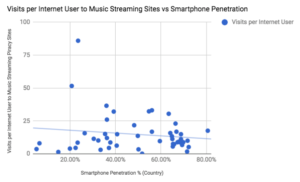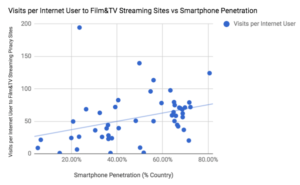John Tegner, our Product Marketing Manager, recently wrote an article for Videonet analysing trends in piracy data throughout 2017. The original piece can be seen here, or you can read his analysis below.
Over the last 20 years, piracy was the disruptor that transformed the music industry: recorded music revenues are now reporting solid growth in the US, largely in part because of the ‘streaming age’ which many are likening to the next format age in music, after vinyl, tape, CD and downloads – streaming revenues now account for a lionshare of total US music industry revenue. Streaming is also fast becoming a globally preferred medium for television and film consumption.‘Netflix is winning the piracy war’ is probably an opinion that you’ve read somewhere online[1]. However audience consumption data and trends for piracy can often tell a different story.
MUSO is an authority on digital piracy, providing the world’s largest dataset on visits and activity around piracy sites, and we provide solutions for rights holders to protect their content, better understand demand and create opportunities from piracy audiences. We feel we’re well placed to challenge opinion or public consensus, when the data doesn’t fully support the narrative.
For instance, MUSO’s global piracy audience measurement for 2017 reveal that visits to piracy sites actually increased in the second half of 2017 with a total of 300 billion visits across the year and an overall 1.6% increase from 2016.
If we take the example of television; we’ve seen the digital revolution already disrupt TV consumption behaviour forever, with more consumers than ever choosing to watch via a streaming service, rather than on live linear TV broadcasts (via a television set). This is perhaps reflected in the fact that in the UK, TV advertising saw its first drop in revenues for seven years and according to Business Insider[2] traditional pay-TV providers saw the loss of 872k subscribers in Q3 2017, marking a 3.1% YoY increase from 559k subscriber losses.
Despite this, the audience’s appetite for serialized entertainment has increased significantly, with time spent watching TV formats online seeing continued growth, and with Netflix announcing in December that its 109m users watched more than 140 million hours of content per day, or 1 billion hours per week in 2017[3]. Yet despite the availability of content across multiple VOD platforms in major TV markets, with flexible catch-up services, and an ever-growing choice of OTT streaming platforms further complimenting the local content offering, MUSO’s piracy consumption data continues to highlight TV shows as the most popular, and most consumed content across piracy sites. In 2017 there was a 3% rise in visits to piracy sites hosting TV content when compared with data from the previous year.
Similarly for music, despite an often held belief and popular statements in the press that streaming services have “killed piracy”[4], our piracy consumption data highlights global visits to piracy music websites surged to a 15% increase from 2016.
Taking a global view, however, doesn’t necessarily provide insight into issues rights owners are facing at a regional, micro or even macro level, with piracy demand generally understood to be impacted equally by social, economic and industrial factors.
Looking closer at a subset of these factors, MUSO has examined a sample of industry data which can help to illuminate potential trends in how platform preference may influence how audiences are accessing the content that they want to consume, with global piracy demand split between mobile devices and desktop devices that looks very different to 2016 consumption. In fact, piracy in 2017 saw a 50/50 split between consumption on each device type, with mobile increasing by 18.6% in the second half of 2017 compared with the first six months of that year. Mobile devices were used to navigate to 87% of total visits to music piracy sites. For TV shows 52% of visits to piracy sites with TV content were through mobile devices – for the first time mobile was favoured over desktop for accessing pirated TV content.
With the increasing proliferation of mobile devices globally[5], it should follow logically that we would observe more pirated content being consumed through mobile devices, and from this a straightforward assumption might be that the increase in smartphone penetration might be in some way driving the increase in pirated content.
Plotting MUSO’s global data for music streaming at a country-level against mobile penetration in these countries however, doesn’t necessarily support this assumption. A linear regression shows no significant correlation (Pearson Correlation Coefficient value of -0.14) between mobile penetration (% per country) and visits to piracy music streaming piracy sites per internet user:

Figure 1: Visits per Internet User to Music Streaming Sites* by % Smartphone Penetration per country[6].
Similarly piracy activity for film and TV piracy streaming activity shows no significant correlation (Pearson Correlation Coefficient value of 0.34) between mobile penetration (% per country) and visits to film and TV piracy streaming sites.

Figure 2: Visits per Internet User to Film & TV Streaming Sites* by % Smartphone Penetration per country[7].
A complex mix of social, attitudinal, economic and technological factors contribute to the continuing rise in internet piracy activity, and as piracy continues to increase and expands across different social circles, we can also expect the narrative around piracy to change. Whilst we were unable to see any significant correlation between mobile device penetration and digital piracy in this snapshot, there appears to be clear potential to test a number of hypotheses by examining specific datasets (such as demographic, economic and technological) relative to piracy consumption data.
In addition to consumption data, another dimension that can be applied to this ongoing research is the behavioural data of online piracy users. “Piracy audience behaviours can represent rich insights for purposes of psychographic audience segmentation” says Paul Briley, MUSO’s Chief Commercial Officer. “These users are just people, who have high intent to both seek out and consume content, but also have characteristics such as affinities to certain brands, and, more often than not, demonstrate a propensity to fully engage and pay for content. From this, we can also start to make more accurate inferences as to factors contributing directly to piracy”.
Overall, our data gives us the potential for testing such hypotheses on an ongoing basis, which we will continue to do in order to better advise the media industries on ways to connect with the audiences who consume this type of content.
*MUSO calculates the number of visits to piracy sites as a ratio to the country’s user internet population. The highest rank (position 1) is given to the country with the highest number of visits per internet user. The countries selected are based on the criteria of having a significant internet population of greater than 1 million people, which results in a chart comparing the top 127 countries which have a qualifying internet population size.
References:
[1] (Bershidsky 2017)
[2] (Tran 2017)
[3] (Matney 2017)
[4] (Titcomb 2016)
[5] (David Murphy 2017)
[6] (Newzoo’s Global Mobile Market Report, April 2017)
[7] Newzoo’s Global Mobile Market Report, April 2017)
Murphy, David. 2017 “2.4bn Smartphone Users in 2017, Says eMarketer | Mobile Marketing Magazine.” n.d. Accessed May 2, 2018. http://mobilemarketingmagazine.com/24bn-smartphone-users-in-2017-says-emarketer.
Bershidsky, Leonid. 2017. “Why Netflix Is Winning the Online Piracy Wars.” Bloomberg.com. Bloomberg. May 2, 2017. https://www.bloomberg.com/view/articles/2017-05-02/why-netflix-is-winning-the-online-piracy-wars.
Matney, Lucas. 2017. “Netflix Users Collectively Watched 1 Billion Hours of Content per Week in 2017.” TechCrunch. December 11, 2017. http://social.techcrunch.com/2017/12/11/netflix-users-collectively-watched-1-billion-hours-of-content-per-week-in-2017/.
Tran, Kevin. 2017. “Big Brands Drive Decline in TV Ad Spend.” Business Insider. BI. November 29, 2017. http://www.businessinsider.com/big-brands-drive-decline-in-tv-ad-spend-2017-11.
Newzoo’s Global Mobile Market Report, April 2017, https://newzoo.com/insights/rankings/top-50-countries-by-smartphone-penetration-and-users/
